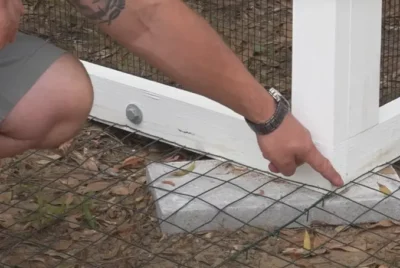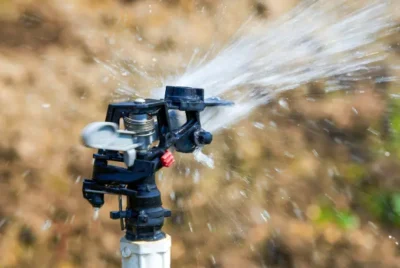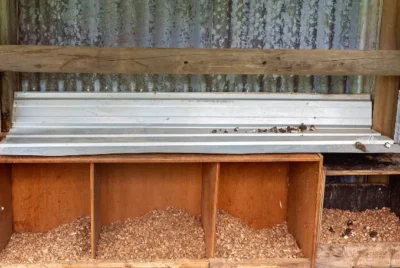Hawk-Proofing Your Coop: Essential Tips for Poultry Owners
Keeping backyard chickens offers numerous benefits, from fresh eggs to delightful companionship. However, the threat of predatory birds, such as hawks, can constantly concern chicken keepers. Hawks are skilled hunters with keen eyesight, and they can pose a danger to your flock.
To ensure the safety of your chickens, it’s essential to implement effective strategies to hawk-proof your coop and outdoor areas. In this article, we’ll explore proven techniques and precautions to protect your feathered friends from hawk attacks.
You Should Put Up Hawk Netting
Hawk netting is a protective measure used to shield your chickens from predatory hawks and other aerial threats. It involves the installation of mesh netting that acts as a physical barrier.
You can employ hawk netting by either surrounding the chicken area with it or covering the area like a roof. When hawks attempt to approach, the netting becomes a visible obstruction, causing hawks to hesitate and ultimately discouraging them from swooping down to prey on your chickens.
This method is effective, cost-efficient, easy to install, and provides long-lasting protection for your flock.
You Can Employ Hawk Deterrents
Hawk deterrents are non-lethal tactics employed to dissuade hawks from targeting your chickens. These methods utilize visual or auditory disruptions that disturb and deter hawks from approaching. There are various types of hawk deterrents available:
- Noise-Making Devices: These produce loud, unexpected sounds such as air horns or motion-activated alarms. The abrupt noises startle hawks, disrupting their hunting behavior and making them cautious about the area.
- Scarecrows: Scarecrows are human-like figures positioned in or near the chicken coop. Although they remain stationary and silent, their presence can intimidate hawks as they associate them with potential threats. Moving scarecrows occasionally can enhance their effectiveness.
- Guard Owls/Decoy Owls: These owl-shaped decoys mimic natural predators like owls. Placing them around the coop can deceive hawks into believing an owl is nearby, which they would normally avoid.
- Predator Eyes: Predator eyes are balloons or diverters featuring menacing eye patterns resembling larger raptors’ eyes, like owls or hawks. Hanging these near the coop can make hawks apprehensive about getting too close.
- Reflective Tape: Strips of reflective tape capture sunlight or other light sources, generating flashes of movement and brightness as they sway in the wind. Since hawks rely on their keen vision, these reflections can confuse and startle them, making them reluctant to approach.

You Should Get a Guardian Animal
- Guard Dog: effective defense against hawk attacks. Guard dogs, such as Great Pyrenees, Anatolian Shepherds, or Maremmas, have been used centuries to protect livestock from predators, including hawks. These dogs are large, powerful, and possess a strong protective instinct. They are not easily intimidated by hawks and will actively patrol the area.
- Add Rooster: Roosters have protective instincts and will often stand guard to alert the hens when they sense danger, such as the presence of hawks. They will make loud crowing sounds and may even engage in defensive behaviors to protect the flock.
- Add Black Chicken to Your Flock: While not a guaranteed method, it is based on the idea that hawks may be superstitious, fear the unusual, or believe that hawks might mistake black chickens for crows or ravens, known to be more challenging prey. Black chickens, such as the Ayam Cemani breed, have solid black plumage and unique appearance.
Pay Attention to the Time of Day
Hawks are diurnal birds of prey, which means they are active during the day. Understanding their daily routine is essential for safeguarding your chickens. When visibility is good, hawks typically start hunting for food in the early morning. They continue hunting until they’ve consumed enough prey to satisfy their needs, which can vary depending on the hawk’s size and hunger.
Consider Seasonal Patterns:
Hawks may exhibit different behaviors and activity levels depending on the season. Spring and fall are periods when hawk activity may increase. During spring, hawks may be more active due to migratory patterns, and they may have young to feed, making them more determined hunters.
Young hawks, in particular, may be bolder and more willing to take risks as they learn to hunt. This makes early spring a potentially risky time for free-ranging chickens. Awareness of these seasonal patterns allows you to take extra precautions when hawk presence is more pronounced, such as using secure enclosures or supervision when your chickens are outside.
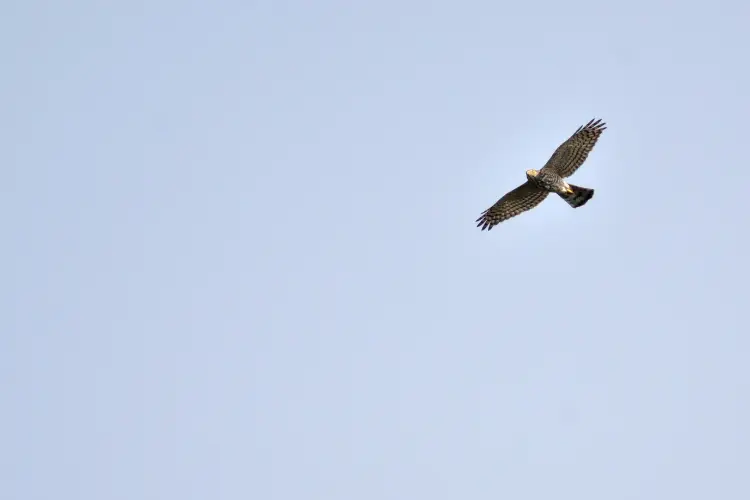
Make Sure to Eliminate Any Attractants That Might Draw Hawks
Hawks are opportunistic predators and are more likely to target an area with readily available food sources. To deter hawks, you should securely store chicken feed and water containers to prevent them from becoming easily accessible to hawks.
Additionally, you must dispose of food scraps properly and not leave them in the open, as they can attract hawks seeking an easy meal.
Consider Planting Protective Plants in Your Garden
Planting protective plants in your garden is a natural and effective method to create barriers that discourage hawks from accessing your chickens. These protective plants, including shrubs, bushes, and trees, serve a dual purpose. They cover your chickens, offering hiding spots where they can take refuge from aerial predators like hawks.
Additionally, these plants obstruct the line of sight for hawks, making it more challenging for them to spot and target your chickens. Planting protective vegetation strategically around your chicken coop and outdoor areas creates an environment less conducive to hawk attacks.
This approach enhances your chickens’ safety and contributes to a visually appealing and functional garden landscape.
Choose Hawk-Proof Feeders and Waterers for Your Property
These specialized containers are designed with barriers and mechanisms that prevent hawks from reaching inside and snatching your chickens while they eat or drink.
Moreover,hawk-proof feeders and waterers offer an additional layer of security, ensuring that your chickens can access their food and water without the risk of hawk attacks.
Apply Camouflage Techniques to Blend in with Your Surroundings
Camouflage techniques involve making your chicken coop and surrounding areas blend in seamlessly with the natural environment. You can achieve this by using earthy colors or painting structures to match the landscape.
Additionally, covering the coop with netting or fencing that reaches the ground and integrating nearby plants can help it blend in and become less noticeable to hawks from above.
Install Automated Sprinklers to Deter Hawks
These sprinklers activate when they detect motion, spraying water and creating a sudden disturbance that startles hawks. The unexpected spray of water disrupts the hunting patterns of hawks and makes them wary of the area, encouraging them to seek quieter locations for their prey.
Also, automated sprinklers are a humane and effective way to protect your chickens from hawks, and their motion-activated feature ensures they activate only when needed.
Set up Perches and Roosts to Provide Safe Spots for Chickens
Hawks often target chickens on the ground, but if you offer plenty of elevated spots, the chickens will spend more time off the ground and be less vulnerable to hawk attacks. It’s crucial to install perches at varying heights and ensure enough space for all the chickens to roost comfortably without overcrowding.
Plus, these elevated spots serve as secure locations where your chickens can rest, roost, and take shelter when they sense danger.
Read also: How to Predator-Proof Your Chicken Coop on a Budget
Evaluate Your Surroundings to Identify Potential Hawk Perches
Hawks often use high vantage points like tall trees, utility poles, or even nearby buildings as perches to spot potential prey.
By identifying these locations, you can plan and take preventative measures to safeguard your chickens. This awareness allows you to implement protective strategies such as positioning your coop and run away from common hawk perches or installing deterrents in those areas to discourage hawks from roosting.
Build a Hawk-Watching Post to Keep an Eye on Local Hawk Activity
Constructing a hawk-watching post is a proactive approach to monitoring local hawk activity and ensuring the safety of your chickens. This post can serve as an elevated platform from which you can use binoculars or a telescope to observe the skies around your property.
By maintaining vigilance, you can spot any hawks that might be nearby and take the necessary steps to protect your chickens promptly. A hawk-watching post helps you proactively safeguard your flock and minimise the risk of attacks.
Read also: Best Cameras for Chicken Coop: Surveillance for Your Flock
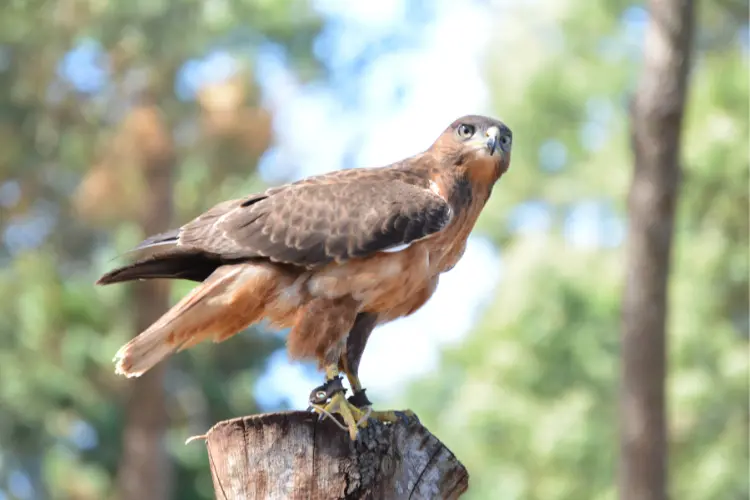
Encourage Community Support in Your Efforts
Collaborating with your community and fellow chicken owners can be a valuable way to enhance the protection of your chickens from hawk attacks. By working together, you can share knowledge, experiences, and resources to strengthen your flock’s safety. Establishing a support network allows you to learn from others’ experiences and develop effective ways to protect your chickens from hawk threats.
Together, you can create a more robust defense against potential hawk attacks, ensuring the well-being of your feathered friends and fostering a sense of collective responsibility for chicken safety in your community.
Invest in Predator-Proof Fencing to Protect Your Birds
Predator-proof fences are designed to be strong and impenetrable to predators like hawks, foxes, raccoons, and coyotes. It is typically constructed from heavy-duty materials such as metal to prevent hawks from breaking through or damaging the fence.
Moreover, investing in predator-proof fencing keeps hawks away and provides comprehensive protection against various types of predators. This fencing serves as a formidable barrier, ensuring the safety and security of your flock by preventing unauthorized access.
For added security, make sure to secure your predator-proof fencing with high-quality Metal Coop Roofing Screws. These screws will ensure that your fencing stays in place and provides maximum protection for your birds.
Read also: Top Reason Why Your Chickens Need a Secure Coop for Safety
Conclusion
Protecting your chickens from hawk attacks is a top priority for every chicken keeper. With these defenses in place, you can enjoy the many rewards of raising backyard chickens while keeping your feathered friends safe from avian predators. Hawk-proofing your coop is an investment in the well-being of your chickens and peace of mind for you as a responsible chicken keeper.



